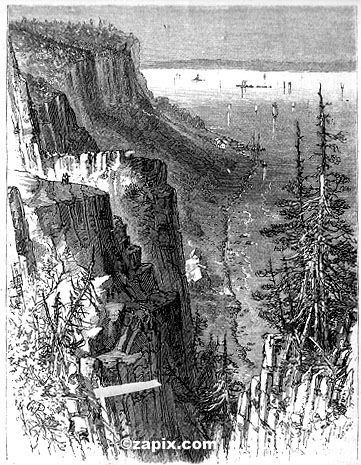|
|
The Romance of the Hudson, Part I, continued
 The Palisades.
From the Morris house, a mile south of Fort Washington, the chief had made a hurried survey of the field of operations, when a young, small, an very pretty vivandière, the wife of a Pennsylvania soldier, who had followed the chief like a guardian angel, from the river, came up reverently, touched his arm, an whispered in his ear. Washington immediately ordered his companions into the saddle, and they galloped back to their boats. Fifteen minutes after they had left the Morris house (late Madame Jumel's), yet standing on Harlem Heights, a British regiment, which had been crawling stealthily, like a serpent, n the rocky acclivity, appeared at the mansion. They had been seen by the vigilant camp-follower, and her whispered warning had saved Washington and his generals from capture. The fort fell, after a severe fight that strewed Mount Washington with graves. Below the beautiful gardens that now adorn Washington Heights repose the mingled remains of American, British, and German soldiers. Many of the survivors of the garrison became the victims of cruelty in the British prisons and prison-ships at New York. Between two hills, one wooded and desolate, the other bare and inhabited, just above Washington Heights, flows a narrow stream. It is Spuyt den Duyvel Creek, which, with the Harlem River, separates Manhattan Island from the main-land. Its queer name often puzzles the curious, who inquire for its origin. Diedrich Knickerbocker solves the problem. He tells us that when Anthony Van Corlear, Governor Stuyvesant's great trumpeter, was on mission to stir up the country to war beyond the Harlem River, he came to this stream. There was no ferry-boat there. The wind was high and the waters were turbulent. Feeling the urgency of his errand, Anthony swore he would cross the creek en spuyt den duyvel (in spite of the devil), and taking a hearty embrace of his stone bottle, he plunged into the stream. When half-way over, he was seen to struggle violently, and giving a vehement blast of his trumpet, sank forever to the bottom. The clangor of the trumpet aroused the people far and near, who hurried to the spot in amazement. "Here an old Dutch burgher," says the chronicler, "famed for his veracity, and who had been a witness of the fact, relate to them the melancholy affair, with the fearful addition (to which I am slow of giving belief) that he saw the devil, in the shape of a huge moss-bunker, seize the sturdy Anthony by the leg and drag him beneath the waves." The stream and the wooded point have been called Spuyt den Duyvel ever since. "Spiting Devil!" shouted the brakeman on a Hudson River car one evening, as the train "slowed" at this spot. "What gave this place so queer a name?" a young woman asked a stranger who was sitting by her side. He told her Irving's story, supposing |
|
Page 7
Books & articles appearing here are modified adaptations
from a private collection of vintage books & magazines. Reproduction of these pages is prohibited without written permission. © Laurel O'Donnell, 1996-2006.
|
|

